
Ficinia spiralis is a coastal sedge endemic to New Zealand. Originally widespread, it has suffered severely from competition with introduced marram grass and animal grazing and now has only a patchy distribution.

Melicytus is a genus of flowering plants in the family Violaceae. Hymenanthera is a synonym.
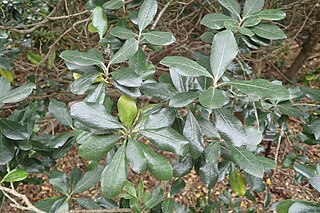
Pittosporum fairchildii, commonly called Fairchild's kohuhu, is a species of plant in the Pittosporaceae family. It is endemic to New Zealand. This species was first described by Thomas Frederic Cheeseman. It is named in honour of Captain J. Fairchild, a 19th-century seaman who commanded the S.S. Stella.

Ficinia nodosa, the knotted club-rush or knobby club-rush, is a rhizomatous perennial in the family Cyperaceae, native to South Africa, Australia, and New Zealand. Widespread in the Southern Hemisphere, Ficinia nodosa grows to between 15 and 220 cm in height. Although it grows best in sandy, salty soil, the plant grows in a wide variety of environments from coastal sand dunes to alpine regions. F. nodosa’s appearance is characterised by dense clusters of long green stems topped with small, rounded flowers often remaining throughout the year.

Leucopogon fasciculatus, the tall mingimingi, is a species of shrub within the family Ericaceae. It is endemic to New Zealand. This species is found in the North Island north of the Bay of Plenty and Taranaki. In the South Island it is found in north west Nelson. It is present in the red and silver beech forests admixed with rimu and miro podocarps on northern South Island.
Rapanea salicina, commonly known as toro, is a species of shrub or small tree native to New Zealand.
Ichneutica blenheimensis is a species of moth in the family Noctuidae. It is endemic to New Zealand and is found throughout the North, South and the Stewart Islands. This species appears to prefer drier eastern localities and is rarely collected in western North Island forested areas. It does not appear to be frequently collected in inland dry tussock grassland habitats. The host plant for the larvae of this species is likely to be the golden sand sedge pīngao which is now absent from the moths type locality. However Chappell has raised very young larvae on grass species and the more developed larvae consumed Phormium tenax. Adults are on the wing from November to March and are attracted to both light and sugar traps. The blackish forewing fringes are diagnostic of this species. But worn specimens of I. arotis can be confused with worn specimens of I. blenheimensis. However I. arotis can be distinguished from I. blenheimensis as it has a scale-tuft on the thorax and dark longitudinal stripes on the tegula. This species is classified as "At Risk, Naturally Uncommon" by the Department of Conservation.
Ichneutica sulcana is a moth of the family Noctuidae. It is endemic to New Zealand and can be found throughout the North, South and Stewart Islands at a range of altitudes from the lowlands to the alpine zone. This species prefers to live in native grass, shrub and wetland habitats as well as in native forest. The larval host plants of this species are forest grasses and sedges and larvae have been reared on Microlaena avenacea and species within the genus Carex. The larva pupates in the soil. Adults are on the wing from December to May but have also been recorded in August and September in the northern parts of the North Island. They are attracted to sugar traps as well as to light. I. sulcana and I. supersulcana are very similar in appearance but can be distinguished as there are differences in the male abdomen and genitalia of the two species. Also these two species do not appear to share a range as I. supersulcana seems to prefer to live at higher altitudes than I. sulcana. I. sulcana might also be confused with I. semivittata but I. sulcana is a larger species with a much darker abdomen and hindwing, and has only 1 to 3 dots on the forewing postmedian line.

Carex capillacea, common name yellowleaf sedge in Tasmania, is a species of sedge found in Assam, the far east of Russia, New Guinea, south east Australia, New Zealand, Malesia, China, Japan and India.
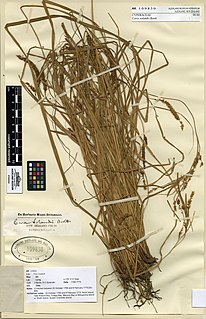
Carex solandri is a species of sedge that was first described by Francis Boott in 1853.
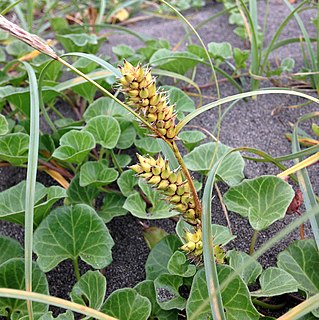
Carex pumila, commonly known as strand sedge or spreading sedge, is a species of sedge of the family Cyperaceae.
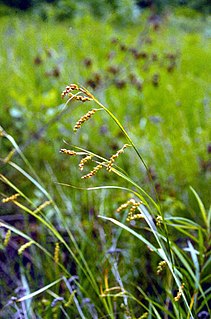
Carex davisii, known as Davis' sedge or awned graceful sedge, is a species of Carex native to North America. It is listed as an endangered, threatened, or species of concern across much of edge of its range. It was named in the 1820s by Lewis David de Schweinitz and John Torrey in honor of Emerson Davis (1798–1866), a Massachusetts educator and "enthusiastic student of the genus" Carex.

Scaevola gracilis is a plant in the family Goodeniaceae, native to the Kermadec Islands and Tonga.
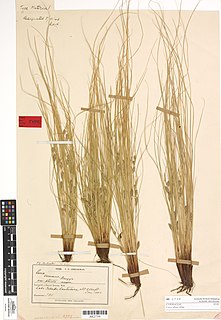
Carex albula, common name white sedge, is a species of sedge. It is endemic to the South Island of New Zealand.

Carex berggrenii, common name Berggren's Sedge, is a species of sedge. It is endemic to New Zealand, being found on both the North and the South Islands.
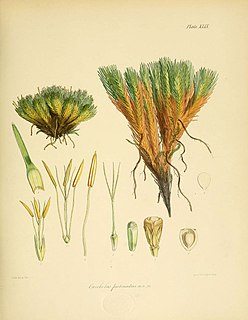
Oreobolus pectinatus is a species of flowering plant in the sedge family that is native to the subantarctic islands, and to the North and South Islands of New Zealand. The specific epithet derives from the Latin, pectin/pectinis,, and refers to the leaves.
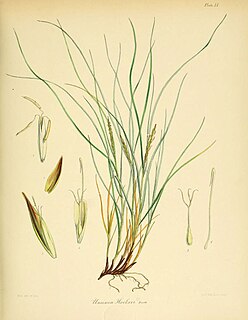
Carex erebus is a member of the sedge family and is found on the Antarctic Islands of Australia and New Zealand.

Carex virgata, the swamp sedge, is a species of flowering plant in the family Cyperaceae. It is native to Tasmania, New Zealand, and the Chatham Islands, and has been introduced to Great Britain. It is used in constructed wetlands for wastewater treatment.

Dracophyllum kirkii is a species of shrub endemic to the South Island of New Zealand. It was first described by Sven Berggren in 1877 and gets the specific epithet kirkii after the New Zealand botanist Thomas Kirk. In the heath family Ericaceae, it inhabits mountain slopes and bluffs and reaches a height of just 20–140 cm (8–55 in). A 2017 assessment using the New Zealand Threat Classification System classified it as “Not Threatened,” giving it an estimated population of more than 100,000.

Dracophyllum acerosum is a species of shrub or small tree endemic to New Zealand's South Island. It was first described by Sven Berggren in 1877 and gets the specific epithet acerosum, meaning needles shaped, for its leaves. In the heath family Ericaceae, it inhabits mountain slopes, ridge lines and hillsides and reaches a height of 1–2 m (3–7 ft). A 2017 assessment using the New Zealand Threat Classification System classified it as “Not Threatened,” giving it an estimated population of more than 100,000.



















